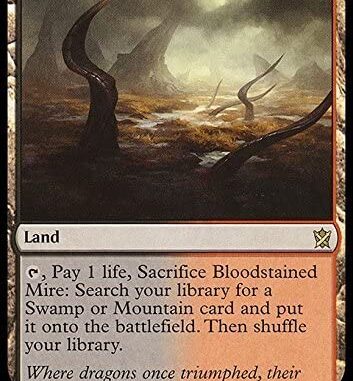
Hi everyone, and welcome back to the Finder’s Archives.
In this column, we take some of the lands from Magic: The Gathering and turn them into something you can use for your fantasy games.
The stats given in each entry assumes that you’re using Pathfinder 2 for your games, but they can easily be converted over into any fantasy system. This week we visit the desolation of the bloodstained mire.
Bloodstained Mire
The Bloodstained Mire is the site of an ancient conflict between dragons. Some say it was two draconic armies, but the dragons themselves maintain that it was the site of a battle between just two dragons – albeit ones of gigantic proportions – possibly avatars of Tiamat and Baphomet, though they have remained silent on the matter.
What is known is that today, the vegetation and waters of the mire are stained with SOMETHING of draconic origin. The water is black and acidic, the trees are coated white with frost, while the leaves burn anyone touching them. Gas erupts from beneath its brackish waters, and the clouds above are always roiling with thunder and lightning, though only rarely are they hit with rain.
Lay of the Land
The Bloodstained Mire stretches out for miles, with its acidic waters eventually being diluted by the surrounding areas, but within the borders of the mire, life persists. Animals have developed a strange form of immunity to the dangers of the environment, but humanoids have had a much harder time, except for kobolds. The kobolds who live here have a much closer connection to their draconic heritage, as evident in their appearance and their abilities. Sorcery is common, as is the ability to use a breath weapon, among these strange creatures. They all speak an ancient dialect of Draconic, one that is difficult for modern creatures to understand. These kobolds are all members of a small tribe called the “Dragonheads,” led by Korgkull, a kobold sorcerer.
The ground of the bloodstained mire is likely the single most disturbing feature of the mire, as, when you start digging, the ground isn’t actually dirt or mud – but once you get three feet or so down, it’s a hundred-foot thick layer of bone marrow and decaying dragon scales. This makes the mud huts that the kobolds live in rather grisly, almost like a building made of mud and trophies.
Dangers
The Bloodstained Mire’s main dangers are the resident kobolds, especially Korgkull – but apart from that, there’s always a constant danger from the environment. Any of the individual elements could cause damage to an individual (usually 1d6 points of damage, from the damage type associated with that particular element (as noted above in the description). Apart from these environmental hazards is one more: sudden quagmires and quicksand that often develops due to cavities in the bone marrow soil. This is very similar to normal quicksand, but with the following profile:
Bonemarrow Quicksand Hazard 5
[Complex] [Environmental]
Complexity Complex
Stealth +13 (trained) (or –10 and no minimum proficiency if the surface is disturbed)
Description A 15-foot-wide patch of bone marrow attempts to submerge creatures that step onto it.
Disable Survival DC 23 (trained) to disturb the surface
Submerge [free action] Trigger A Huge or smaller creature walks onto the bonemarrow quicksand. Effect The triggering creature sinks into the bone marrow quicksand up to its waist. The quicksand rolls initiative if it hasn’t already.
Routine [1 action] On its initiative, the bonemarrow quicksand pulls down each creature within it. A creature that was submerged up to its waist becomes submerged up to its neck, and a creature that was submerged up to its neck is pulled under and has to hold its breath to avoid suffocation. Furthermore, the creature takes 2d6 bludgeoning damage and 1d6 randomized damage (between acid, cold, electricity, and fire) at the end of its turn.
A creature in the quicksand can attempt a DC 22 Athletics check to Swim to either raise itself by one step if it’s submerged to its neck or worse, or to move 5 feet if it’s submerged only up to its waist. On a critical failure, the creature is pulled down one step. A creature that Swims out of the bonemarrow quicksand escapes the hazard and is prone in a space adjacent to the bonemarrow quicksand patch. Other creatures can Aid the creature, typically by using a rope or similar aid, or attempt to pull the creature out with their own DC 22 Athletics check, with the same results as if the creature attempted the check.
Reset The hazard still submerges anyone who walks in, but the surface doesn’t become hidden again until it settles over the course of 24 hours.
